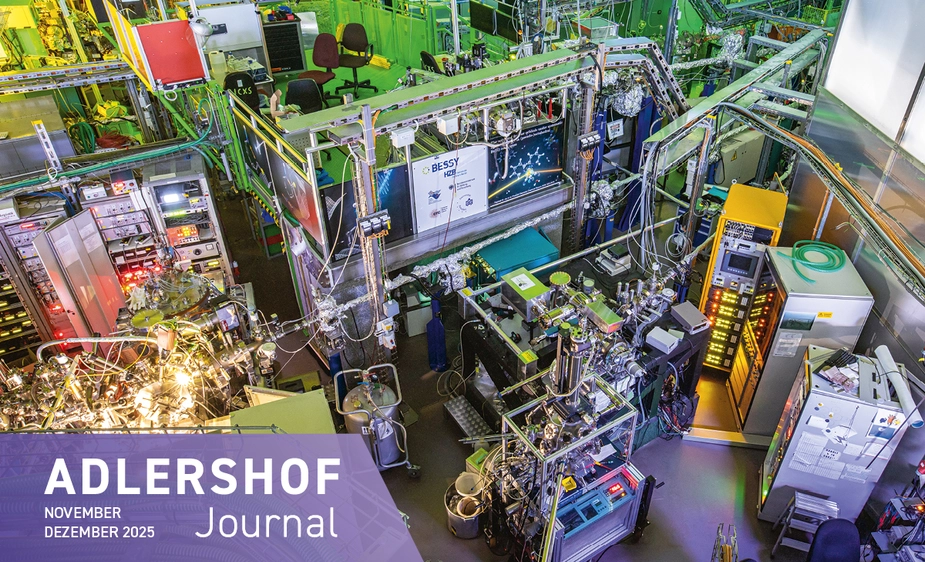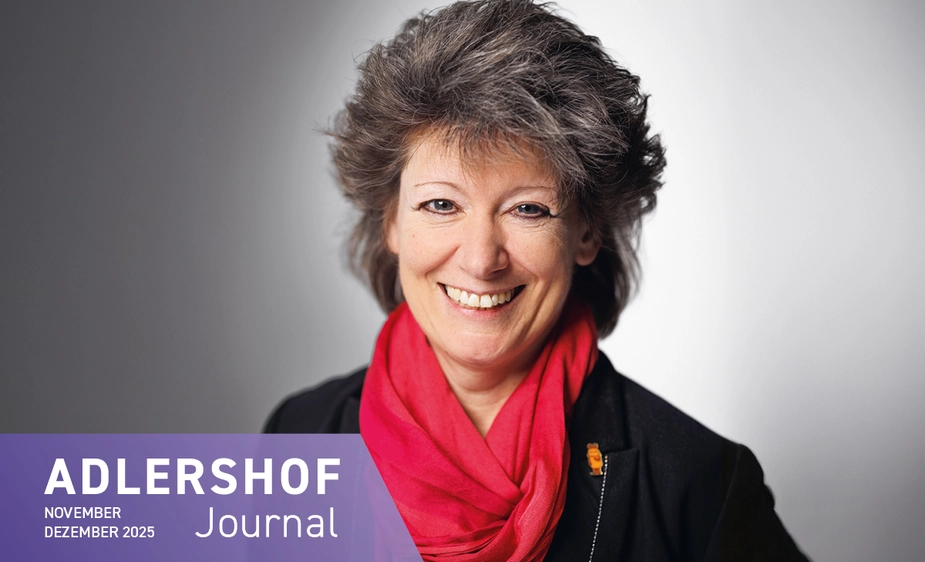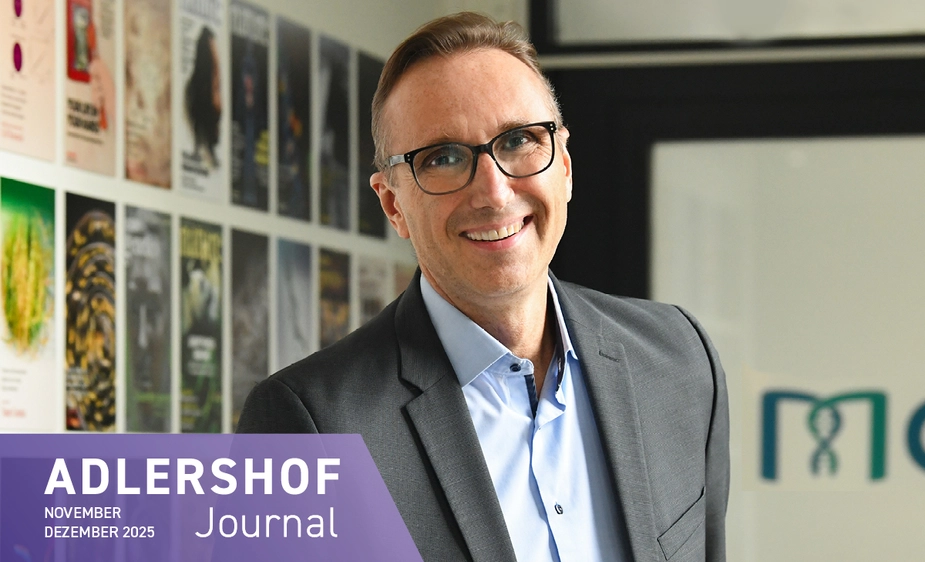Time matters
Which research questions call for short measurement times, and which analyses require longer ones? A brief journey through time and the Adlershof campus
Watching molecular and atomic building blocks while they work? This is made possible by operando studies. Such deep insights at an atomic resolution are facilitated by BESSY II, a research facility operated by the Helmholtz Centre Berlin for Materials and Energy (HZB). This Berlin-based synchrotron radiation source generates extremely bright X-ray light (synchrotron radiation) to explore physical and chemical processes in materials. It’s an indispensable tool for research in materials science, energy, health, and fundamental research.
BESSY II has been delivering insights and accelerating the path to progress for almost 25 years. It does so at very different rhythms: decades, months, weeks, minutes, seconds, and even femtoseconds. A femtosecond equals one quadrillionth of a second. The relation of a femtosecond to a full second is comparable to that of a second to about 32 million years. The result: Such ultrashort time intervals allow researchers to observe chemical reactions in slow motion, tracking the movements of atoms and molecules.
Researchers like Anje Vollmer. With a PhD in chemistry, she set up and managed an experimental station at BESSY II for eight years before moving into user coordination a decade ago. Over time, she says, expectations and measurement times have changed significantly. “In the past, experiments often lasted up to two weeks. Today, shorter measurement periods of a few days are much more common.”
However, even in the femtosecond range, she notes, data are now collected over longer periods. It used to be that mainly synchrotron experts used BESSY II. “Our user base today is much broader, which also requires more support by the beamline scientists,” says Vollmer. Users now require far more infrastructures, sample environments, laboratories, and complementary measurement techniques. “We’re responding to this with new labs, closer integration between synchrotron and offline methods, and thematic ‘villages’ that bring together several measuring stations and lab infrastructures.”
At BESSY I, 90 percent of projects originally came from the field of physics. At BESSY II, that figure is closer to 45 percent. The rest is largely made up of users from chemistry, biology, biochemistry, medicine, and even archaeology. “We’re seeing a clear shift toward more chemically driven research questions—catalysis, energy materials, batteries,” says Vollmer. In general, energy research is in high demand: “With over 35 percent of projects focusing on catalysis, energy materials, and batteries, these topics are particularly sought-after.”
BESSY II continues to adapt to new research needs—and is creating better conditions for long-term guests. “We’re currently setting up a measuring station that will allow studies to run over several years,” Vollmer reports. In doing so, the samples in question (such as novel batteries) will effectively stay at a “sample hotel”. Vollmer: “Like hotel guests, our samples will do what’s typical in a hotel: have breakfast or work out at the gym.” In other words, they undergo chemical changes or “exercise” by charging and discharging their cells. “They will do so over hundreds or thousands of cycles, potentially spanning years,” says Vollmer.
Axel Hentsch is not able to think in such timeframes. A chemist at Alliance Medical Radiopharmacy Berlin GmbH, he works with extremely short-lived radiotracers used in nuclear medicine diagnostics. The timing is extremely tight—because the product perishes. More specifically: They have a short half-life. Half-life denotes the period in which half of a substance’s radioactive nuclei decay and transform into other nuclei. The company produces a radioactive isotope of fluorine: fluorine-18 (¹⁸F). “The ¹⁸F atom is chemically incorporated into tracers to visualise disease processes in the body,” explains Hentsch. The substance is used as a tracer in positron emission tomography (PET). “It decays with a half-life of about 110 minutes and accumulates in metabolic processes— such as the increased glucose consumption of cancer cells,” says Hentsch. It’s their hunger for sugar that helps make tumours visible. The relatively short half-life of fluorine-18 also means that the radiation exposure for patients quickly subsides, making it barely higher than that of an X-ray image.
Hentsch and his entire team have to be on the ball: “The substance has to be used within 14 hours.” This calls for tightly coordinated logistics. Production in the cyclotron starts at midnight, and the first batch is ready by around 3.30 am. The delivery drivers transporting it to radiology practices and clinics are already waiting outside the building. Since it is impossible to carry out the necessarily strict quality control at this stage, the transport boxes are secured with combination locks. Users receive the code granting access to the radioactive material only after their samples have passed inspection. “Many things here happen at the same time,” says Hentsch drily. He himself remains unfazed by the pressure and appears perfectly calm.
By contrast, MGI Tech GmbH has to take a more enduring approach, ensuring that tumour diseases are treated quickly and precisely. This life-science technology provider develops processes that allow clinicians to carry out swift genome analyses. DNA extraction and preparation, the actual analysis, and bioinformatic evaluation are all delivered from a single source.
“This is a valuable tool for developing new therapies, for health management, and for precision medicine diagnostics,” explains Christian Zimmermann from the company’s sales team.
The timescales vary depending on the task: A risk-gene analysis aimed at targeting a tumour with a personalised therapy can produce results within hours, or, at the very most, within days. Large-scale population analyses, processing hundreds of thousands of samples and collecting information on test subjects, can take months or even years.
It can take decades for researchers to draw conclusions from them that lead to new insights into healthy lifestyles or the design of preventive measures for at-risk groups. In this way, the young Adlershof-based company contributes to improving global healthcare—and will need staying power to keep doing so.
Chris Löwer for Adlershof Journal



